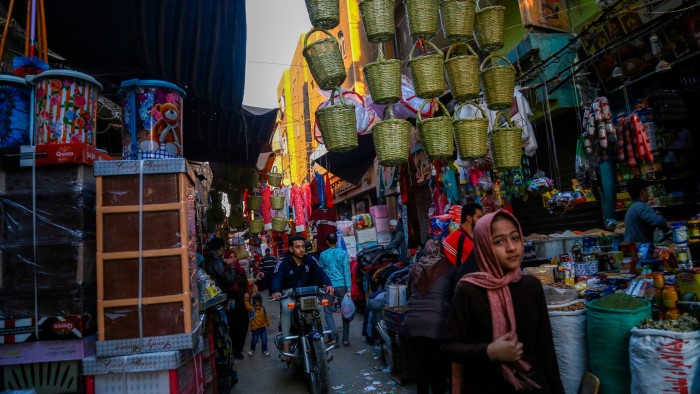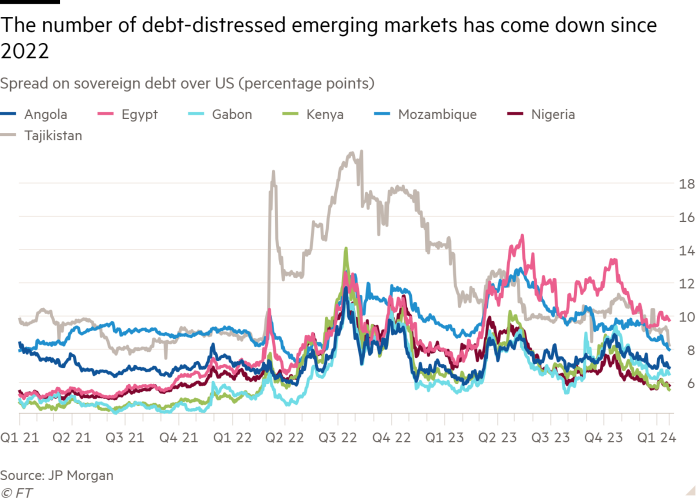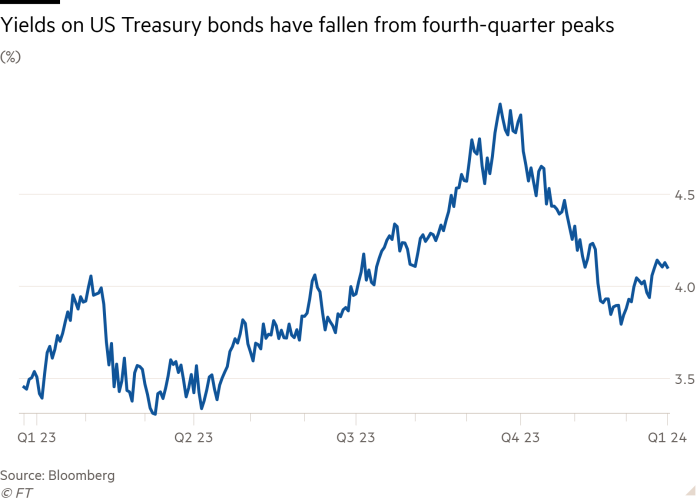Bond market thaw offers hope to emerging market borrowers

Roula Khalaf, Editor of the FT, selects her favourite stories in this weekly newsletter.
Bond investors are warming to a host of countries locked out of international markets for the past two years, raising hopes that a debt crisis in the developing world may be starting to ease.
A global bond rally over the past two months, in anticipation of interest rate cuts in the US and other big economies, has swept up riskier debt as investors seek higher returns.
The resulting fall in borrowing costs has helped to pull countries out of debt distress, commonly defined as a dollar-borrowing cost more than 10 percentage points higher than that of US Treasuries, which in effect bars a government from issuing new debt.
Ten nations — Angola, Egypt, El Salvador, Gabon, Iraq, Kenya, Mongolia, Mozambique, Nigeria and Tajikistan — have now seen their borrowing spreads fall below this threshold since 2022.
That raises the prospect that more developing countries will be able to refinance their debt with fresh borrowing rather than joining the raft of economies that defaulted in the wake of the Covid-19 pandemic.
“It is looking better overall, and what has improved is access to financing,” said Simon Waever, global head of emerging markets sovereign credit strategy at Morgan Stanley. “I do think there is a chance that some who have been excluded from markets will have access now.”

Ivory Coast further buoyed optimists this week by becoming the first sub-Saharan African country to issue an international bond in nearly two years as it raised $2.6bn on the market. Investors now expect other issuers with “junk” level credit ratings to follow.
“Ivory Coast has definitely benefited from the improving mood and falling yields,” said Paul Greer, an emerging markets debt portfolio manager at Fidelity International. Greer added he expects “the disinflation momentum will continue, letting some others come to market this year”.
While a fall in bond yields in the US and other developed markets — which makes emerging market assets more attractive to investors — has been the biggest driver of the rally, economists also point to falling oil and wheat prices that have eased pressure on some emerging economies.
“If we look back to 2022, debt-distress concerns were at their height, pushing many of these economies into unsafe territories,” said William Jackson, chief emerging markets economist at Capital Economics. “The Federal Reserve was about to raise interest rates and US bond yields were rising quickly. Commodity prices were rising from the war in Ukraine. But all of those have started to reverse.”
There are still questions over appetite to lend money to these countries, however, as some investors continue to be burnt by post-Covid defaults that have yet to be resolved. Zambia, Sri Lanka and other defaulters have been falling behind on restructuring debts because of disputes among creditors.
Despite relatively few defaults since 2022, flows of money back into hard currency emerging market debt have been scant, one fund manager said. “A lot of it has to do with the experience on the restructuring side.”
There is also hesitancy on whether the falling spreads are a sufficient indicator that countries can access the markets and not default on new credit.
“These rates are not indicative, and are largely driven by expectations for US bonds,” said Emre Tiftik, director of sustainability research at the International Institute for Finance. “There are remaining tensions in domestic debt and government expenses that suggest that some of these countries will not be able to access capital markets.”

And while the yield gap relative to US Treasuries has shrunk, many riskier emerging economies would still probably face daunting double-digit borrowing costs.
Some countries may prefer to avoid fresh borrowing on the bond market and instead seek cheaper financing such as more loans from the IMF and other official lenders — at the cost of conditions on policy.
“For countries that do not default, they will stretch out the pain by using multilateral capital to continue paying off rising debts and by further squeezing government expenditures,” said Bright Simons, vice-president of research at Ghanaian think-tank Imani.
Most governments close to debt distress already rely on support from multilateral lenders such as the IMF and World Bank to help them defray debt costs and avoid default. The International Development Association, the part of the World Bank that provides low-interest loans to the poorest countries, dispersed a record $27 billion in 2023.
Last year, debt-distressed Egypt released two yen-denominated Samurai bonds with the Africa Finance Corporation as a guarantor. Kenya, meanwhile, is exploring debt for climate swaps, in which a portion of debt is cancelled in return for commitments to address climate change, following the lead of other debt-distressed countries such as Ecuador.
But analysts warn that such schemes might not be enough to stop more emerging economies from reneging on their borrowing, as Ethiopia did in December.
“There is a better global outlook for the next few quarters, especially in [formerly distressed] countries,” said Sergi Lanau, director of global emerging markets strategy at Oxford Economics. “But we should still expect some sovereign defaults.”
Additional reporting by Joseph Cotterill
Comments